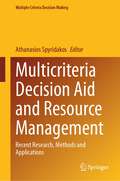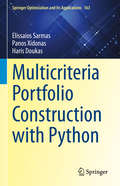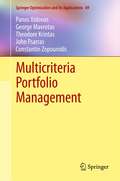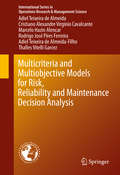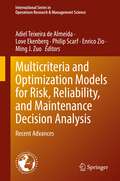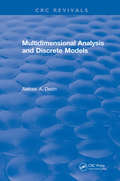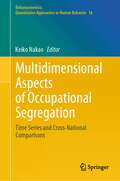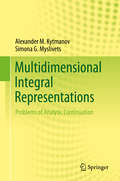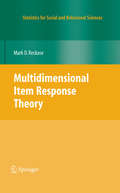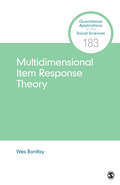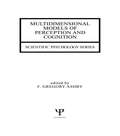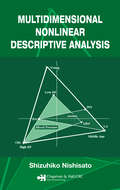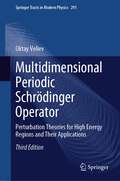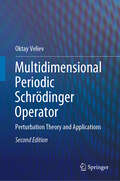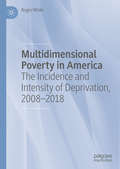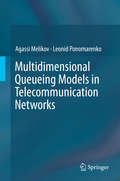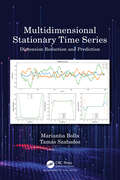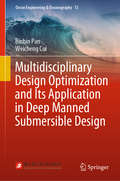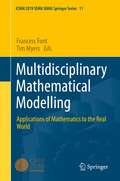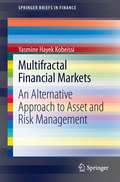- Table View
- List View
Multicriteria Decision Aid and Resource Management: Recent Research, Methods and Applications (Multiple Criteria Decision Making)
by Athanasios SpyridakosThis book is focused on the application of methodological approaches and systems of multiple criteria decision analysis (MCDA) in the field of resource management. Resource management constitutes a major challenge of modern times. The book comprehensively examines cases of human resources, material resources and natural resources in particular. It focuses on the efficient utilization of these resources to achieve sustainability of economic, environmental and social aspects. Also, the book presents methodological tools which aim to support the decision making at operational, executive and strategic levels.The book presents recent results of scientific research in the field of MCDA and its applications to resource management. It investigates the resource management challenges and introduces innovative methodological approaches and systems for addressing these resources management issues.
Multicriteria Portfolio Construction with Python (Springer Optimization and Its Applications #163)
by Panos Xidonas Haris Doukas Elissaios SarmasThis book covers topics in portfolio management and multicriteria decision analysis (MCDA), presenting a transparent and unified methodology for the portfolio construction process. The most important feature of the book includes the proposed methodological framework that integrates two individual subsystems, the portfolio selection subsystem and the portfolio optimization subsystem. An additional highlight of the book includes the detailed, step-by-step implementation of the proposed multicriteria algorithms in Python. The implementation is presented in detail; each step is elaborately described, from the input of the data to the extraction of the results. Algorithms are organized into small cells of code, accompanied by targeted remarks and comments, in order to help the reader to fully understand their mechanics. Readers are provided with a link to access the source code through GitHub.This Work may also be considered as a reference which presents the state-of-art research on portfolio construction with multiple and complex investment objectives and constraints. The book consists of eight chapters. A brief introduction is provided in Chapter 1. The fundamental issues of modern portfolio theory are discussed in Chapter 2. In Chapter 3, the various multicriteria decision aid methods, either discrete or continuous, are concisely described. In Chapter 4, a comprehensive review of the published literature in the field of multicriteria portfolio management is considered. In Chapter 5, an integrated and original multicriteria portfolio construction methodology is developed. Chapter 6 presents the web-based information system, in which the suggested methodological framework has been implemented. In Chapter 7, the experimental application of the proposed methodology is discussed and in Chapter 8, the authors provide overall conclusions.The readership of the book aims to be a diverse group, including fund managers, risk managers, investment advisors, bankers, private investors, analytics scientists, operations researchers scientists, and computer engineers, to name just several. Portions of the book may be used as instructional for either advanced undergraduate or post-graduate courses in investment analysis, portfolio engineering, decision science, computer science, or financial engineering.
Multicriteria Portfolio Management
by Theodore Krintas Constantin Zopounidis John Psarras Panos Xidonas George MavrotasThe primary purpose in this book is to present an integrated and innovative methodological approach for the construction and selection of equity portfolios. The approach takes into account the inherent multidimensional nature of the problem, while allowing the decision makers to incorporate specified preferences in the decision processes. A fundamental principle of modern portfolio theory is that comparisons between portfolios are generally made using two criteria; the expected return and portfolio variance. According to most of the portfolio models derived from the stochastic dominance approach, the group of portfolios open to comparisons is divided into two parts: the efficient portfolios, and the dominated. This work integrates the two approaches providing a unified model for decision making in portfolio management with multiple criteria.
Multicriteria and Multiobjective Models for Risk, Reliability and Maintenance Decision Analysis
by Adiel Teixeira de Almeida Cristiano Alexandre Virgínio Cavalcante Marcelo Hazin Alencar Rodrigo José Pires Ferreira Adiel Teixeira de Almeida-Filho Thalles Vitelli GarcezThis book integrates multiple criteria concepts and methods for problems within the Risk, Reliability and Maintenance (RRM) context. The concepts and foundations related to RRM are considered for this integration with multicriteria approaches. In the book, a general framework for building decision models is presented and this is illustrated in various chapters by discussing many different decision models related to the RRM context. The scope of the book is related to ways of how to integrate Applied Probability and Decision Making. In Applied Probability, this mainly includes: decision analysis and reliability theory, amongst other topics closely related to risk analysis and maintenance. In Decision Making, it includes a broad range of topics in MCDM (Multi-Criteria Decision Making) and MCDA (Multi-Criteria Decision Aiding; also known as Multi-Criteria Decision Analysis). In addition to decision analysis, some of the topics related to Mathematical Programming area are briefly considered, such as multiobjective optimization, since methods related to these topics have been applied to the context of RRM. The book addresses an innovative treatment for the decision making in RRM, thereby improving the integration of fundamental concepts from the areas of both RRM and decision making. This is accomplished by presenting an overview of the literature on decision making in RRM. Some pitfalls of decision models when applying them to RRM in practice are discussed and guidance on overcoming these drawbacks is offered. The procedure enables multicriteria models to be built for the RRM context, including guidance on choosing an appropriate multicriteria method for a particular problem faced in the RRM context. The book also includes many research advances in these topics. Most of the multicriteria decision models that are described are specific applications that have been influenced by this research and the advances in this field. Multicriteria and Multiobjective Models for Risk, Reliability and Maintenance Decision Analysis is implicitly structured in three parts, with 12 chapters. The first part deals with MCDM/A concepts methods and decision processes. The second part presents the main concepts and foundations of RRM. Finally the third part deals with specific decision problems in the RRM context approached with MCDM/A models.
Multicriteria and Optimization Models for Risk, Reliability, and Maintenance Decision Analysis: Recent Advances (International Series in Operations Research & Management Science #321)
by Enrico Zio Adiel Teixeira de Almeida Ming J. Zuo Love Ekenberg Philip ScarfThis book considers a broad range of areas from decision making methods applied in the contexts of Risk, Reliability and Maintenance (RRM). Intended primarily as an update of the 2015 book Multicriteria and Multiobjective Models for Risk, Reliability and Maintenance Decision Analysis, this edited work provides an integration of applied probability and decision making. Within applied probability, it primarily includes decision analysis and reliability theory, amongst other topics closely related to risk analysis and maintenance. In decision making, it includes multicriteria decision making/aiding (MCDM/A) methods and optimization models. Within MCDM, in addition to decision analysis, some of the topics related to mathematical programming areas are considered, such as multiobjective linear programming, multiobjective nonlinear programming, game theory and negotiations, and multiobjective optimization. Methods related to these topics have been applied to the context of RRM. In MCDA, several other methods are considered, such as outranking methods, rough sets and constructive approaches. The book addresses an innovative treatment of decision making in RRM, improving the integration of fundamental concepts from both areas of RRM and decision making. This is accomplished by presenting current research developments in decision making on RRM. Some pitfalls of decision models on practical applications on RRM are discussed and new approaches for overcoming those drawbacks are presented.
Multidimensional Analysis and Discrete Models
by Aleksei A. DezinMultidimensional Analysis and Discrete Models, a thorough and detailed reference, covers the main structures of multidimensional analysis and the intrinsically defined discrete models in applied mathematics, mathematical physics, and related fields. The material is presented in a clear and straightforward manner, with background information provided to define finite models and to clarify the concepts of multidimensional analysis. The book covers special difference models of the mathematical physics equations, models of boundary value problems, and objects of quantum mechanics. Considerable attention is also given to differential operators on Riemannian manifolds and the interpretation of classical vector analysis.The primary focus of Multidimensional Analysis and Discrete Models is on the description of regular methods of constructing intrinsically defined discrete models for special classes of continual objects, but emphasis is also given to the interaction of ideas and methods that exist throughout the field of mathematics. For example, the connections between theories derived from classical and functional analysis, Riemannian geometry, and algebraic topology are illustrated, and are discussed in terms of their relevance to computing solutions.
Multidimensional Aspects of Occupational Segregation: Time Series and Cross-National Comparisons (Behaviormetrics: Quantitative Approaches to Human Behavior #18)
by Keiko NakaoOne of the strengths of this book is that it expresses occupational segregation from multidimensional viewpoints using correspondence analysis. Through a quantitative approach, the book examines occupational segregation by education and gender in response to industrial transformation in Japan and other countries. The transformation of industrial structure, such as post-industrialization, demands a reconsideration of traditional perspectives in sociology, especially in social stratification. In other words, it is a shift from the attribute to the achievement principle. Higher technological innovations will create higher levels of industries, and those industries will require jobs that need greater human capital. In short, the meritocracy will be promoted. Meritocracy is certainly considered persuasive. In fact, previous researchers have looked primarily at a person’s occupation as a measure of social status. In Japan, jobs are normally acquired after completing education; thus, one’s educational achievement plays an important role. Especially in recent years, however, education alone has not been enough to explain social status. This book, therefore, focuses on occupational segregation by gender in addition to education in post-industrial society. Can occupational segregation by gender be weakened in the highly educated group? Is this a universal story in modern society? Because post-industrialization is part of the larger story of modernization, international perspectives are needed to examine the linkage between education and gender occupational segregation. This book explores occupational segregation by gender in response to industrial transformation in Japan and other countries.
Multidimensional Differential and Integral Calculus: A Practical Approach
by Giorgio Riccardi Bruno Antonio Cifra Enrico De BernardisThis textbook proposes an informal access to the most important issues of multidimensional differential and integral calculus. The traditional style—characterized by listing definitions, theorems, and proofs—is replaced by a conversational approach, primarily oriented to applications. The topics covered, developing along the usual path of a textbook for undergraduate courses, are always introduced by thoroughly carried out examples. This drives the reader in building the capacity of properly use the theoretical tools to model and solve practical problems. To situate the contents within a historical perspective, the book is accompanied by a number of links to the biographies of all scientists mentioned as leading actors in the development of the theory.
Multidimensional Discrete Unitary Transforms: Representation: Partitioning, and Algorithms (Signal Processing and Communications)
by Artyom M. Grigoryan Sos S. AgaianThis reference presents a more efficient, flexible, and manageable approach to unitary transform calculation and examines novel concepts in the design, classification, and management of fast algorithms for different transforms in one-, two-, and multidimensional cases. Illustrating methods to construct new unitary transforms for best algorithm sele
Multidimensional Integral Representations
by Alexander M. Kytmanov Simona G. MyslivetsThe monograph is devoted to integral representations for holomorphic functions in several complex variables, such as Bochner-Martinelli, Cauchy-Fantappiè, Koppelman, multidimensional logarithmic residue etc. , and their boundary properties. The applications considered are problems of analytic continuation of functions from the boundary of a bounded domain in C^n. In contrast to the well-known Hartogs-Bochner theorem, this book investigates functions with the one-dimensional property of holomorphic extension along complex lines, and includes the problems of receiving multidimensional boundary analogs of the Morera theorem. This book is a valuable resource for specialists in complex analysis, theoretical physics, as well as graduate and postgraduate students with an understanding of standard university courses in complex, real and functional analysis, as well as algebra and geometry.
Multidimensional Item Response Theory
by M. D. ReckaseFirst thorough treatment of multidimensional item response theory Description of methods is supported by numerous practical examples Describes procedures for multidimensional computerized adaptive testing
Multidimensional Item Response Theory (Quantitative Applications in the Social Sciences #183)
by Wes BonifaySeveral decades of psychometric research have led to the development of sophisticated models for multidimensional test data, and in recent years, multidimensional item response theory (MIRT) has become a burgeoning topic in psychological and educational measurement. Considered a cutting-edge statistical technique, the methodology underlying MIRT can be complex, and therefore doesn’t receive much attention in introductory IRT courses. However author Wes Bonifay shows how MIRT can be understood and applied by anyone with a firm grounding in unidimensional IRT modeling. His volume includes practical examples and illustrations, along with numerous figures and diagrams. Multidimensional Item Response Theory includes snippets of R code interspersed throughout the text (with the complete R code included on an accompanying website) to guide readers in exploring MIRT models, estimating the model parameters, generating plots, and implementing the various procedures and applications discussed throughout the book.
Multidimensional Item Response Theory (Quantitative Applications in the Social Sciences #183)
by Wes BonifaySeveral decades of psychometric research have led to the development of sophisticated models for multidimensional test data, and in recent years, multidimensional item response theory (MIRT) has become a burgeoning topic in psychological and educational measurement. Considered a cutting-edge statistical technique, the methodology underlying MIRT can be complex, and therefore doesn’t receive much attention in introductory IRT courses. However author Wes Bonifay shows how MIRT can be understood and applied by anyone with a firm grounding in unidimensional IRT modeling. His volume includes practical examples and illustrations, along with numerous figures and diagrams. Multidimensional Item Response Theory includes snippets of R code interspersed throughout the text (with the complete R code included on an accompanying website) to guide readers in exploring MIRT models, estimating the model parameters, generating plots, and implementing the various procedures and applications discussed throughout the book.
Multidimensional Models of Perception and Cognition (Scientific Psychology Series)
by F. Gregory AshbyThe mental representations of perceptual and cognitive stimuli vary on many dimensions. In addition, because of quantal fluctuations in the stimulus, spontaneous neural activity, and fluctuations in arousal and attentiveness, mental events are characterized by an inherent variability. During the last several years, a number of models and theories have been developed that explicitly assume the appropriate mental representation is both multidimensional and probabilistic. This new approach has the potential to revolutionize the study of perception and cognition in the same way that signal detection theory revolutionized the study of psychophysics. This unique volume is the first to critically survey this important new area of research.
Multidimensional Nonlinear Descriptive Analysis
by Shizuhiko NishisatoQuantification of categorical, or non-numerical, data is a problem that scientists face across a wide range of disciplines. Exploring data analysis in various areas of research, such as the social sciences and biology, Multidimensional Nonlinear Descriptive Analysis presents methods for analyzing categorical data that are not necessarily sam
Multidimensional Periodic Schrödinger Operator
by Oktay VelievThe book describes the direct problems and the inverse problem of the multidimensional Schrödinger operator with a periodic potential. This concerns perturbation theory and constructive determination of the spectral invariants and finding the periodic potential from the given Bloch eigenvalues. The unique method of this book derives the asymptotic formulas for Bloch eigenvalues and Bloch functions for arbitrary dimension. Moreover, the measure of the iso-energetic surfaces in the high energy region is construct and estimated. It implies the validity of the Bethe-Sommerfeld conjecture for arbitrary dimensions and arbitrary lattices. Using the perturbation theory constructed in this book, the spectral invariants of the multidimensional operator from the given Bloch eigenvalues are determined. Some of these invariants are explicitly expressed by the Fourier coefficients of the potential. This way the possibility to determine the potential constructively by using Bloch eigenvalues as input data is given. In the end an algorithm for the unique determination of the potential is given.
Multidimensional Periodic Schrödinger Operator: Perturbation Theories for High Energy Regions and Their Applications (Springer Tracts in Modern Physics #291)
by Oktay VelievThis book describes the direct and inverse problems of the multidimensional Schrödinger operator with a periodic potential, a topic that is especially important in perturbation theory, constructive determination of spectral invariants and finding the periodic potential from the given Bloch eigenvalues. It provides a detailed derivation of the asymptotic formulas for Bloch eigenvalues and Bloch functions in arbitrary dimensions while constructing and estimating the measure of the iso-energetic surfaces in the high-energy regime. Moreover, it presents a unique method proving the validity of the Bethe–Sommerfeld conjecture for arbitrary dimensions and arbitrary lattices. Using the perturbation theory constructed, it determines the spectral invariants of the multidimensional operator from the given Bloch eigenvalues. Some of these invariants are explicitly expressed by the Fourier coefficients of the potential, making it possible to determine the potential constructively using Bloch eigenvalues as input data. Lastly, the book presents an algorithm for the unique determination of the potential.This updated and significantly expanded third edition features an extension of this framework to all dimensions, offering a now complete theory of self-adjoint Schrödinger operators within periodic potentials. Drawing from recent advancements in mathematical analysis, this edition delves even deeper into the intricacies of the subject. It explores the connections between the multidimensional Schrödinger operator, periodic potentials, and other fundamental areas of mathematical physics. The book's comprehensive approach equips both students and researchers with the tools to tackle complex problems and contribute to the ongoing exploration of quantum phenomena.
Multidimensional Periodic Schrödinger Operator: Perturbation Theory and Applications
by Oktay VelievThis book describes the direct and inverse problems of the multidimensional Schrödinger operator with a periodic potential, a topic that is especially important in perturbation theory, constructive determination of spectral invariants and finding the periodic potential from the given Bloch eigenvalues. It provides a detailed derivation of the asymptotic formulas for Bloch eigenvalues and Bloch functions in arbitrary dimensions while constructing and estimating the measure of the iso-energetic surfaces in the high-energy regime. Moreover, it presents a unique method proving the validity of the Bethe–Sommerfeld conjecture for arbitrary dimensions and arbitrary lattices. Using the perturbation theory constructed, it determines the spectral invariants of the multidimensional operator from the given Bloch eigenvalues. Some of these invariants are explicitly expressed by the Fourier coefficients of the potential, making it possible to determine the potential constructively using Bloch eigenvalues as input data. Lastly, the book presents an algorithm for the unique determination of the potential. This updated second edition includes an additional chapter that specifically focuses on lower-dimensional cases, providing the basis for the higher-dimensional considerations of the chapters that follow.
Multidimensional Poverty in America: The Incidence and Intensity of Deprivation, 2008-2018
by Roger WhiteThis book investigates and documents multidimensional poverty in the United States and identifies patterns and relationships that contribute to the development of a more complete understanding of the incidence and intensity of deprivation. The first part introduces multidimensional poverty and provides a rationale for viewing poverty through a lens of multiple deprivations. It discusses how the Multidimensional Poverty Index (MPI) compares to more narrowly-focused, income-based poverty measures and emphasizes its usefulness and applicability for the formulation of related, welfare-enhancing public policies. The second part documents multidimensional poverty incidence, intensity, and corresponding MPI values at the aggregate level of detail, for various demographic cohorts, and across geographic locales. The book then presents results from an empirical analysis that identifies the determinants of multidimensional poverty incidence and of individual deprivation scores. The third part consists of three studies of multidimensional poverty, examining the effect of the Affordable Care Act on multidimensional poverty incidence and intensity, variation in multidimensional poverty across native- and foreign-born residents (and across immigrants’ home countries) of the US, and variation in the respective indicators that contribute to multidimensional poverty across the life cycle. The book closes with two chapters. The first relays the findings of counterfactual exercises where certain deprivations are assumed to have been eliminated. The final chapter summarizes the work, draws inferences and arrives at conclusions, and discusses the corresponding public policy implications.
Multidimensional Queueing Models in Telecommunication Networks
by Leonid Ponomarenko Agassi MelikovThe increasing complexity of telecommunication networks requires us to develop adequate mathematical models. We must find their characteristics, optimize them subject to chosen criteria, and develop the corresponding control algorithms. Multidimensional queueing models are used to design and optimize modern and next-generation networks (NGN). The central problem of the related mathematical theory is to apply multidimensional and large-size queueing models to improve efficiency. In this book new methods are successively developed and applied to solve related problems. The book is recommended for researchers engaged with the mathematical theory of telecommunications traffic.
Multidimensional Stationary Time Series: Dimension Reduction and Prediction
by Marianna Bolla Tamás SzabadosThis book gives a brief survey of the theory of multidimensional (multivariate), weakly stationary time series, with emphasis on dimension reduction and prediction. Understanding the covered material requires a certain mathematical maturity, a degree of knowledge in probability theory, linear algebra, and also in real, complex and functional analysis. For this, the cited literature and the Appendix contain all necessary material. The main tools of the book include harmonic analysis, some abstract algebra, and state space methods: linear time-invariant filters, factorization of rational spectral densities, and methods that reduce the rank of the spectral density matrix. Serves to find analogies between classical results (Cramer, Wold, Kolmogorov, Wiener, Kálmán, Rozanov) and up-to-date methods for dimension reduction in multidimensional time series Provides a unified treatment for time and frequency domain inferences by using machinery of complex and harmonic analysis, spectral and Smith--McMillan decompositions. Establishes analogies between the time and frequency domain notions and calculations Discusses the Wold's decomposition and the Kolmogorov's classification together, by distinguishing between different types of singularities. Understanding the remote past helps us to characterize the ideal situation where there is a regular part at present. Examples and constructions are also given Establishes a common outline structure for the state space models, prediction, and innovation algorithms with unified notions and principles, which is applicable to real-life high frequency time series It is an ideal companion for graduate students studying the theory of multivariate time series and researchers working in this field.
Multidisciplinary Design Optimization and Its Application in Deep Manned Submersible Design (Ocean Engineering & Oceanography #13)
by Weicheng Cui Binbin PanThis book investigates Reliability-based Multidisciplinary Design Optimization (RBMDO) theory and its application in the design of deep manned submersibles (DMSs). Multidisciplinary Design Optimization (MDO) is an effective design method for large engineering systems like aircraft, warships, and satellites, which require designers and engineers from various disciplines to cooperate with each other. MDO can be used to handle the conflicts that arise between these disciplines, and focuses on the optimal design of the system as a whole. However, it can also push designs to the brink of failure. In order to keep the system balanced, Reliability-based Design (RBD) must be incorporated into MDO. Consequently, new algorithms and methods have to be developed for RBMDO theory.This book provides an essential overview of MDO, RBD, and RBMDO and subsequently introduces key algorithms and methods by means of case analyses. In closing, it introduces readers to the design of DMSs and applies RBMDO methods to the design of the manned hull and the general concept design. The book is intended for all students and researchers who are interested in system design theory, and for engineers working on large, complex engineering systems.
Multidisciplinary Mathematical Modelling: Applications of Mathematics to the Real World (SEMA SIMAI Springer Series #11)
by Francesc Font Tim G. MyersThis book presents a selection of the talks resulting from research carried out by different groups at the Centre de Recerca Matemàtica and presented at the International Congress on Industrial and Applied Mathematics, held in Valencia in 2019. The various chapters describe a wide variety of topics: cancer modelling, carbon capture by adsorption, nanoscale diffusion and complex systems to predict earthquakes. These mathematical studies were specifically aided via collaborations with biomedical engineers, physicists and chemists. The book is addressed to researchers in all of these areas as well as in general mathematical modelling.
Multifidelity Modeling in Vibration Analysis
by Ranjan GanguliMultifidelity Modeling in Vibration Analysis teaches users how to make predictions about physical systems in a computationally inexpensive manner.The aim of this book is to introduce the concept of multifidelity modeling through structural dynamics case studies. The book focuses on vibration analysis problems to illustrate how multifidelity methods work. Two key methods — the response surface methods and the co-kriging method — are discussed to present the reader with state of the art practices that are easy to implement. Also, two different physics-based mathematical models of a system, the Euler-Bernoulli beam model and the Timoshenko beam model, are used at two disparate levels of discretization.This book will help graduate students, researchers, and scientists who are interested in applying multifidelity models to uncertainty quantification, optimization, and robust and reliability-based design problems of vibration of engineering systems.
Multifractal Financial Markets
by Yasmine Hayek KobeissiMultifractal Financial Markets explores appropriate models for estimating risk and profiting from market swings, allowing readers to develop enhanced portfolio management skills and strategies. Fractals in finance allow us to understand market instability and persistence. When applied to financial markets, these models produce the requisite amount of data necessary for gauging market risk in order to mitigate loss. This brief delves deep into the multifractal market approach to portfolio management through real-world examples and case studies, providing readers with the tools they need to forecast profound shifts in market activity.
